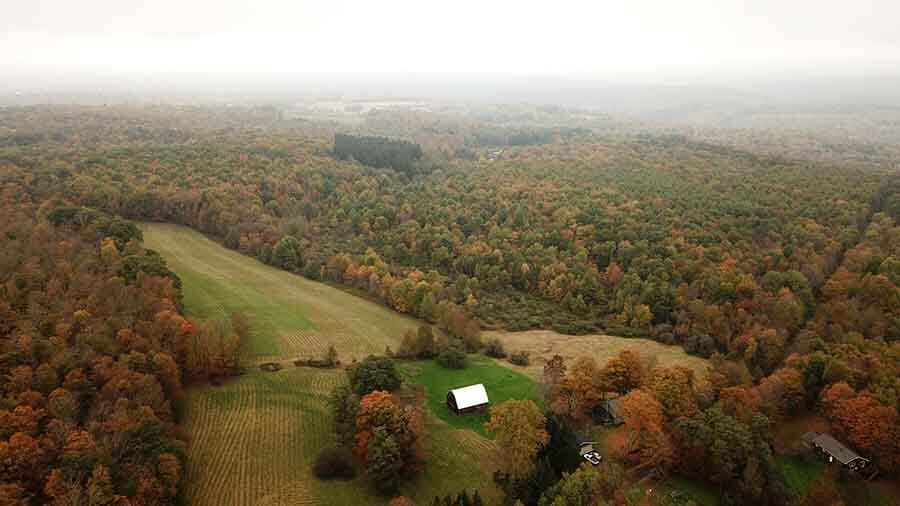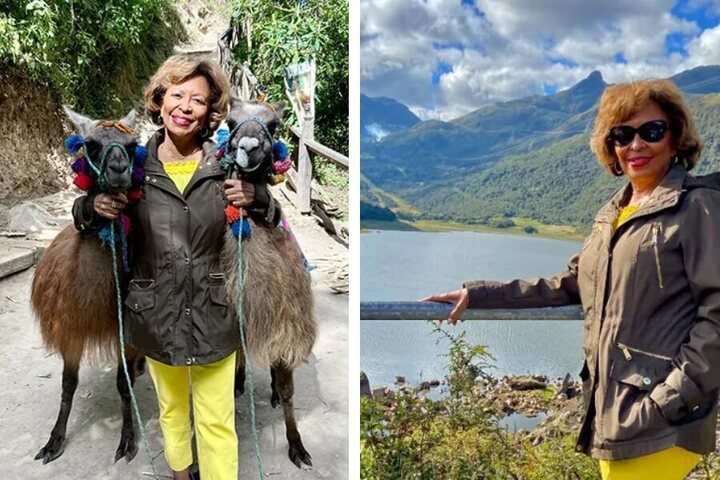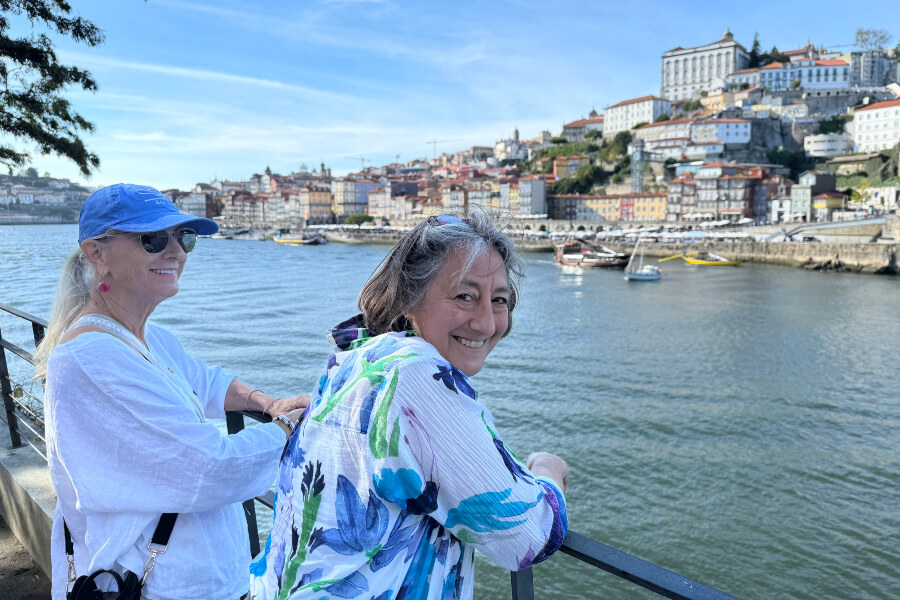Most of us harbor dreams of alternate lives we wish we could lead. One of my friends wants to live in a Sprinter van as she tours Spain’s sun-baked Costa del Sol. Another wants to spend a year learning how to make whiskey somewhere way, way up in the Scottish Highlands.
But it’s not every day that you meet someone who actually goes out and does exactly what they always daydreamed about. And it’s once in a blue moon that you meet someone who has done so not once, but twice, and at midlife versus in the full flower of youth.
Enter one Karen Shafer, a warm, unassuming, silver-haired New Yorker, who is doing just that. Since rounding the corner of midlife, she’s been putting her dreams into action in two distinct and daring ways.
A Different Kind of Heading South

Karen on the ice road.
At age 65, Karen retired from her arts administration job at New York City’s acclaimed Lincoln Center for the Performing Arts and went off to fulfill a long-held yet perhaps unlikely dream: She headed to Antarctica and became a real-life ice-road trucker.
The seed had been planted some 40 years earlier, when a friend had told her enthralling stories about working near the South Pole, amid penguins, pressure ridges of ice that looked like enormous, glorious sculptures, and a white snowy world all around. Karen was fascinated, and a voice inside her said, I want to do that.
That voice stayed inside her for decades: “My career unfolded, and I just never got around to it,” she says, “Though on my 50th birthday, someone gave me a book on Antarctica, so I guess I was talking about it more than I realized.”
Finally, 35 or more years after her dream took root, she was there amid the ice.
Then, as time passed and retirement came into focus, Karen had a realization. “I said to myself, if you want to do an adventure, you probably shouldn’t push off much longer, as your physical capacity could diminish,” she recalls. As a single woman, she had no family ties keeping her from traveling. And as planning got serious, she set her sights on the United States Antarctic Program, a scientific exploratory project that’s managed by the National Science Foundation. Every year, it sends about 3,000 people to Antarctica to conduct or support research.
As her last year at Lincoln Center began, she got to training. “My office was on the 11th floor, and when everyone else would take their coffee break, I would take a 10-minute stair-climbing break. I kept weights on my couch at home and would hoist them around. Since I was planning to be part of a government team in Antarctica, I figured they wouldn’t reject me for my age, but I certainly would need to pass a physical. It was such a great feeling when those 10 flights of stairs became easy!”
But what role would she play way down south? Taking an administrative job like the one she held in New York seemed logical, but a friend who knew about such things said a desk job would keep her stuck in a windowless office. “’What you want,’ he said,” she recalls, “’is to be a driver, out in the environment.’”
One small problem: While Karen had driven artists around town during her career, she certainly hadn’t climbed into the cab of a truck on a stretch of frozen earth. How to train to be a vehicle operator in this icy climate? A friend who was a Rotary Club member upstate put her in touch with a Department of Transportation trainer who got Karen behind the wheel of bigger and bigger rigs until—yes!!—she was a truck driver. Not of an 18-wheeler, but the Delta, more like what’s known as a box truck.
The pieces fell into place and physicals were passed, and the first week of the following October, she flew to New Zealand, where it was spring, and headed to McMurdo Station, which looks like a puddle of light amid the barren terrain, via Air Force transportation. “I was glued to the little porthole window of the plane. The landscape was like nothing I’d ever seen. I was so filled with excitement. Finally, 35 or more years after dream took root—I was there amid the ice!” she says, her eyes sparkling at the memory of the frozen cliffs and dramatic, desolate expanses.
Read More: Meet Wendy Caldwell, A Police Rookie at 54
All Ice, All the Time

Karen in Antarctica with her trusty Delta.
As she stowed her duffel bag under the bed in her barracks-like dorm, which she shared with up to five other women, she realized just what a change this would be. Due to the relentless cold, survival clothing was provided, so everyone looks identical. Food was served cafeteria-style: breakfast, lunch, dinner, and what was called Mid-rats for the “midnight rats” working the night shift (there are 24 hours of daylight in the summer there), who’d wander in at all hours saying, “What meal am I even here for?”
Going to Antarctica as a truck driver in my 60s was a denial of age.
Karen drove people all around—“Shuttle Shafer” was her radio handle—and got to see the glorious landscape. “You’d see a lone Emperor penguin by the side of the road, but the Adelie penguins, they scurry around in packs. You’ve heard about herding cats? Herding those penguins is quite similar. It’s someone’s job at the big airport runway to clear the penguins off,” she says with a laugh.
The community there was a tight-knit one—and so welcoming that Karen spent two seasons there and made lasting friends. Being older (by a lot) than her colleagues, she and her dorm-mates took to calling themselves “Aunt Karen and the Ice Children,” like a rock band.
There was limited internet access, so the experience was all about making your own fun and connecting with people who harbored the same unusual dream to be in the white-on-white landscape. “You’d find a PhD working in the galley because they wanted the ice experience,” she notes. Scientists based in Antarctica would give lectures about their research for the workers, and there were touches of creativity and humor woven throughout the landscape. Time was spent in the former officers’ club, which was set up as a coffee house (one that served wine), with a stage beckoning anyone who wanted to sing or play guitar and add to the warm mood.
Art and the Outdoors

Karen at Aunt Karen’s Farm with Dr. Adele Fournet, a musician who completed four brand new compositions as a resident.
Being creative is the heartbeat of Karen’s life, and it’s her current passion as she navigates another reinvention that’s been in the works for years. It’s been her dream to give back to the creative community, and house by house, parcel by parcel, she’s been crafting an artistic colony in upstate New York called Aunt Karen’s Farm. Its mission is to support the natural environment and serve artists who sometimes need to get the hell out of New York City.
The artists who come to her farm have coined the phrase ‘art-i-culture.’
Karen’s adventures upstate began back in 1988, when she needed some countryside in her life—an escape from her studio apartment. “Studies show that being in nature has an important and positive on our health and creativity,” she says. With a friend in tow, she bought some land with a rather dilapidated house on it. That moment wound up triggering a slow buying spree, as over the years Karen accumulated multiple properties on over 100 contiguous acres.
The sweep of fertile earth originally served as her escape from the stress of city life and blossomed into an informal place for visual and performing artists to relax, connect with nature, and create. Couples brought their greenery-starved city kids with them who called the idyll “Aunt Karen’s Farm”—and the name stuck.
Over the years, Aunt Karen’s Farm became a more formal arts-incubator residency site. Located not far from the baseball-centric town of Cooperstown, with its rich cultural heritage, the farm has welcomed artists of all sorts—composers, choreographers, writers, videographers—developing new work, often with partners and children in tow, which is a rarity for residencies. It’s been home to whole theatrical companies working on new productions, with Karen stopping in to chat, to encourage, and to help with laundry and any other chores.
Now, however, Karen is focusing on her legacy, carefully delegating responsibilities and also expanding her scope. She’s hired the farm’s first full-time manager and is expanding her mission in new directions as bonds deepen with the local agriculture college, SUNY Cobleskill’s Institute for Rural Vitality. “I live in New York City, know nothing about agriculture,” says Karen. “I’m lucky if a houseplant survives.”
But after spending so much time upstate, she decided to explore sustainable ways to utilize the acreage. And so the Aunt Karen Foundation for Culture and Environment was launched to elevate “the recognition that earth is our home, and it’s our human responsibility to take care of our home,” she says. “We work with the next generation of both farmers and artists in defining the importance of nutrition and the relevance of family farm. We are exploring the genesis of the word culture being a part of the word agriculture. The artists who are involved with us have coined the phrase ‘art-i-culture.’”
As artists and students set about their work, sheep graze and free-range hens wander the property, and a pollinator garden is taking root, creating a funky slice of paradise where art and environmentalism merge.
Read More: Susan Zirinsky Is the First Female President of CBS News—But Getting There Wasn’t Easy
Aging and New Adventures

An aerial view of Aunt Karen’s Farm. Image: Tom MacDonald
Karen is frank about keeping her creative fires alive as the years pass. “The aging process is an interesting one,” she muses. “We reminisce over the past, cling to the present, and avoid the inevitable future.” The path forward demands balancing fighting and accepting our age, she says. “Going to Antarctica as a truck driver in my 60s was a denial of age. It was about pushing ahead and behaving like I had a younger body and staying moving … what’s that saying? A body in motion stays in motion!”
Evolving the family farm … is embracing my age.
“Evolving the family farm from a hobby to a not-for-profit organization, an artist residency site, and developing a multi-generational team of participants is embracing my age,” she adds. “It’s recognizing that aging is real and I won’t be here forever. Two very different projects, both conceived while working full-time, both actualized during retirement with different motivations and different goals. But always with excitement about the challenges in front of us.”
Which is a beautiful call to action for all of us who nurture dreams of projects and possibilities ahead.
***
Janet Siroto has held the Editor-in-Chief position at Time Inc.’s Family Life magazine, as well as senior editorial positions at Cosmopolitan, Redbook and Good Housekeeping. Her writing work has appeared in New York, The New York Times, Vogue and many others.




















0 Comments